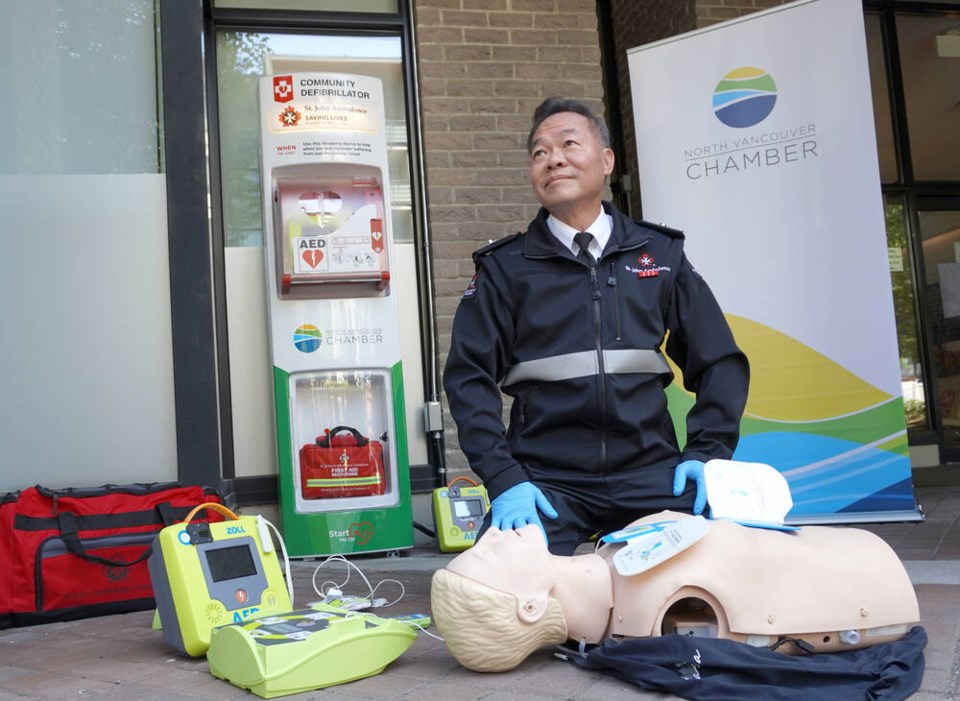Standing outside the North Vancouver Chamber’s office on West First Street is a new tower loaded with lifesaving tools available to anyone in the public when they are in need.
It’s got a first aid kit and naloxone but most notably, it has the first street-facing automated external defibrillator, or AED, on the North Shore.
There are about 25 others in the province and more than hundred are on their way. It’s part of a new philosophy and strategy to make sure the tools are available and simple enough to use by virtually any bystander.
Every year, there are about 35,000 cardiac arrests in Canada. The likelihood of surviving one drops by 10 per cent every minute after person’s heart stops.
“We can all do the math on that. If [help] happens quickly, we have a great outcome. And if there’s nothing available, no CPR, no AED, the outcome is not going to be great,” said Ty Speer, CEO for St. John Ambulance B.C./Yukon, which provided the tower and AED to the chamber. “We want people to have safe communities. We want people to have healthy lives. These are great tools to do that.”
How the AED works
From the time someone opens the door containing the AED, it sounds and alarm and the machine begins speaking out clear instructions along with showing easy-to-understand animations on a small screen.
“Stay calm. Check for responsiveness. Call for help,” the machine dictates as Tony Tsang, medical first responder and superintendent for St. John Ambulance, prepares to do a demonstration on a dummy lying on the sidewalk.
The kit includes scissors to cut through garments, as well as gloves and a CPR mask. For the more hirsute patient, the bag also has a razor that could be used to shave someone’s chest allowing the AED’s pads to stick properly.
More than delivering a high-voltage jolt, which cardiologists describe has being like a kick to the chest from a horse, the machine is able to monitor the patient’s symptoms. If the patient isn’t truly in cardiac arrest, the machine will detect that and won’t deliver a shock.
“The computer will tell you whether you’re doing something right or you’re doing something wrong,” Tsang said.
The instructions are intended to be simple enough that even the dummy Tsang is demonstrating on might be able to use it.
“We need to make sure people are informed that it’s okay to use the machine. People have to have confidence that they can do it,” Speer said.
Lives will be saved
No one was more pleased to see the device installed than Ken Carrusca. In 2018, he found himself on the business end of an AED after he collapsed and went into cardiac arrest while playing hockey in Burnaby.
“Obviously I’m here today to tell the tale,” he said. “I can tell you – these AEDs, they really work.”
Today, Carrusca dedicates part of his time to lobbying for defibrillators being available, or even mandated, in more places – especially schools. West Vancouver currently has the devices at every school, while North Vancouver School District only has them in high schools.
St. John Ambulance approached the chamber asking if there were any member businesses that might want to host an AED and Stafford-Smith volunteered the chamber itself to be the first recipient.
“I’m really hoping that there will be more of these deployed across North Vancouver, across the North Shore. My goal in the long term is for people to know where these are, just like they know where their ATM is,” he said.
While there’s no question that having more ready access to AEDs will make a difference, Speer said, he urges everyone to get up-to-date first aid and CPR training. No one ever regrets having the training once they’ve used it to save a life, he said.
“I think they feel amazing, right? Can there be any better contribution that you can make as a citizen to help somebody?”



